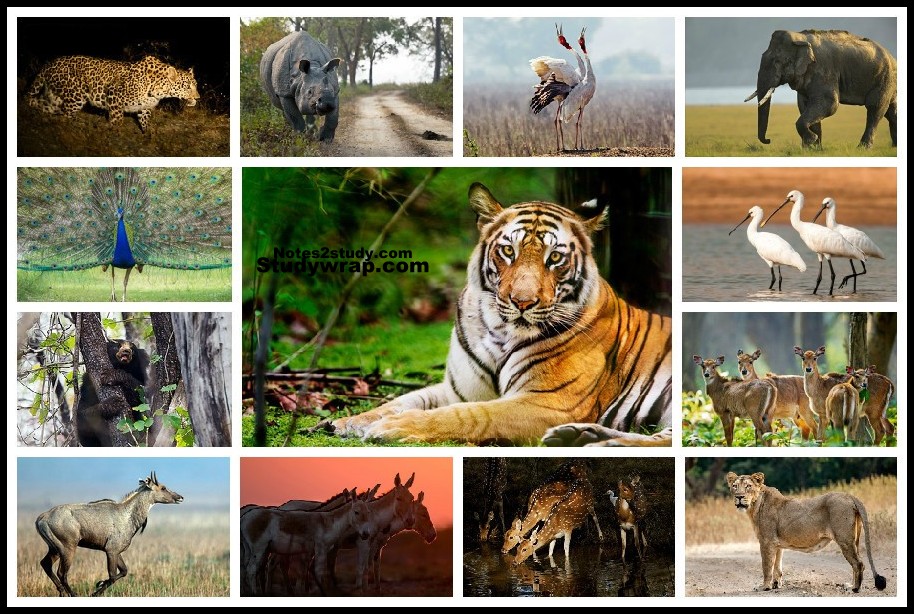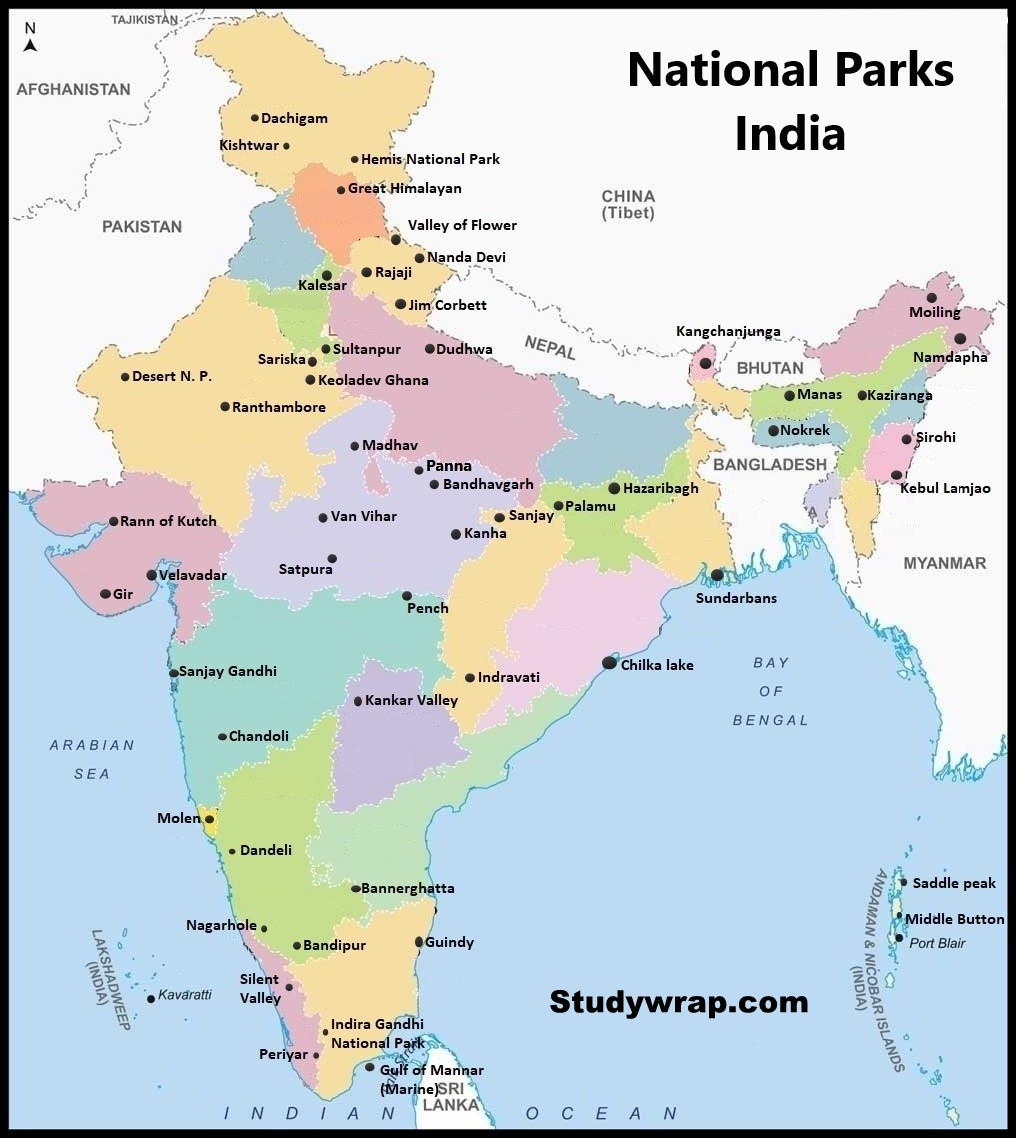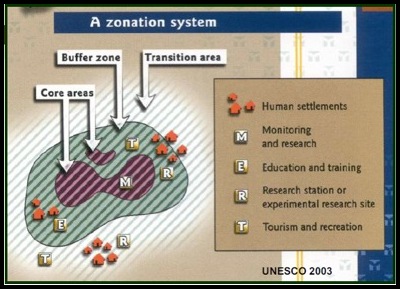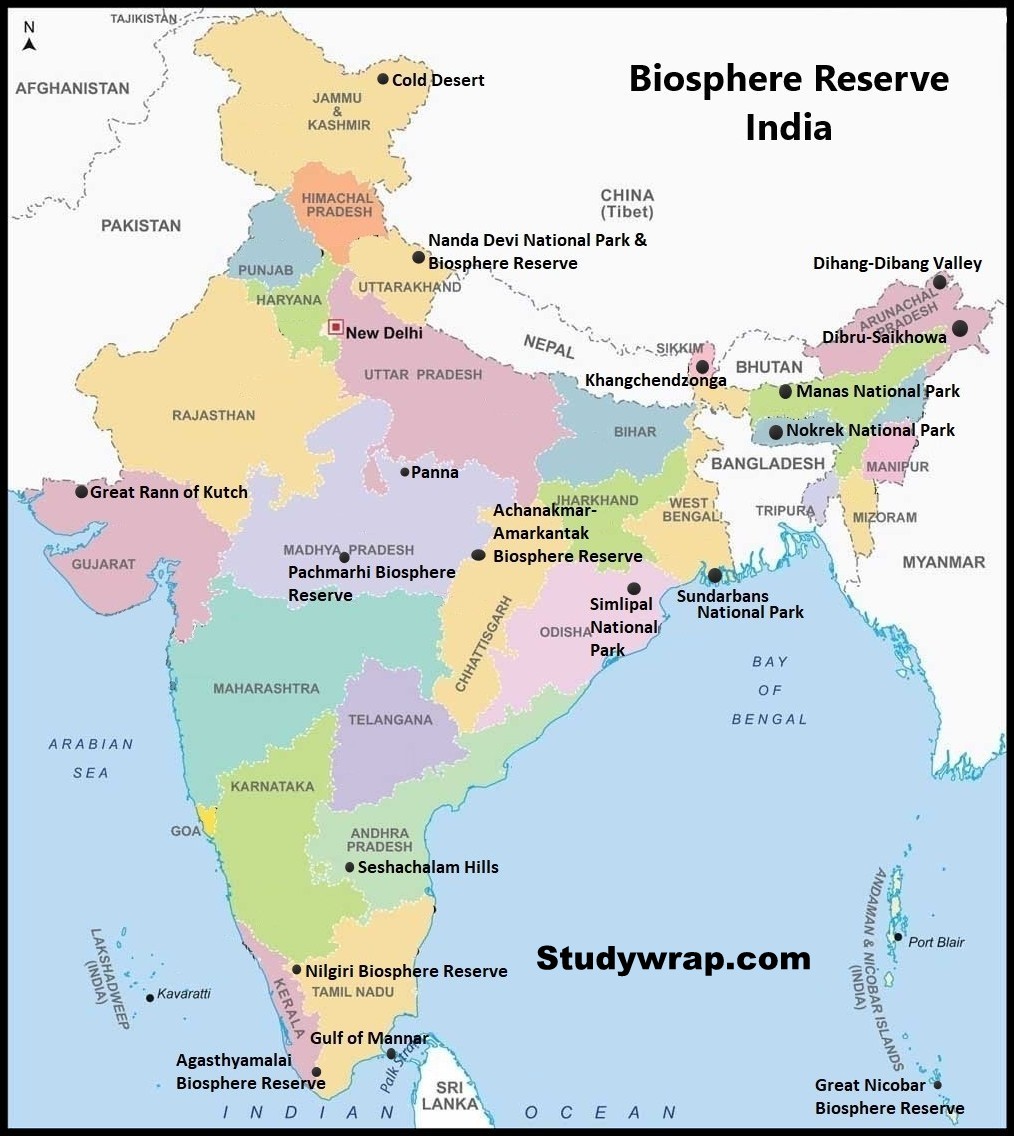Wildlife of India – Protected Areas for wildlife
Wildlife of India & Protected Areas for wildlife
Table of Contents
- Wildlife comprises animals, birds and insects living in the forest.
- Indian forest have a wide range of habitats due to varying topography, Climate and edaphic Variations, which is responsible for wide varieties of wildlife in India.
- India is one of the 17 mega diverse countries of the world. With only 2.4% of total world’s land area, 16.7% of the World’s Human population and 18% livestock, it contributes about 8% of known global biodiversity, however putting enormous demand on our Natural Resources.
- India boasts about more than 90000 species of animals which is about 6.5% of the world’s total.
- Indian Fauna includes about6500 invertebrates, 5000 molluscs, 2546 species of fishes, and 2000 species of Birds, 458 species of reptiles, 4 species of panthers and over 60000 species of insects.

Some Important Species
|
Animals |
Studywrap.com |
|
Mammals |
||
|
1. |
Elephant |
|
|
2. |
One Horned Rhinoceros |
|
|
3. |
Tigers |
|
|
4. |
Cheetahs |
|
|
5. |
Arboreal Clouded Leopard |
|
|
6. |
Black Panther |
|
|
7. |
Lynx |
|
|
8. |
Arna or Wild Buffalo |
|
|
9. |
Gaur or Indian Bison |
|
|
10. |
Yak |
|
|
11. |
Kastura or Musk Deer |
|
|
12. |
Monkeys |
|
|
13. |
Deer |
|
|
14. |
Barasingha |
|
|
15. |
Munjac or Barking Deer |
|
|
16. |
Sheep |
|
|
17. |
Goats |
|
|
Besides these various other species such as Chinkara or the Indian Gazelle, Black buck or Indian Antelope, The nilgai or Blue bull, The Chawsinga, Wild Dog, The Fox, The Jackals, The Hyena, The Mongoose, moles, bats, rodents and squirrels etc. are other mammals found in India. |
||
Reptiles |
||
|
1. |
Snakes |
|
|
2. |
Crocodile |
|
|
3. |
Lizards |
|
|
4.
|
Turtles |
|
Birds |
||
|
||
|
1.
|
Aquatic Birds |
|
|
2. |
Waders and Shore Birds |
|
|
3. |
Ground Birds |
|
|
4. |
Prey Birds |
|
|
5. |
Others |
|
Preservation of Wildlife
- Fast depleting forest cover of India has adversely affected wildlife of India.
- The Indian Constitution entails the subject of forests and wildlife in the Concurrent list thus laying the responsibility of wildlife conservation on both the Centre and the State. The Federal Ministry acts as a guiding torch dealing with the policies and planning on wildlife conservation, while the provincial Forest Departments are vested with the responsibility of implementation of national policies and plans.
a. Indian Board for Wildlife, 1952
-
- Objective – to advise the government on the means of conservation and protection of wildlife, construction of national parks, sanctuaries and zoological gardens as well as promoting public awareness regarding conservation of wildlife.
b. The Wildlife (Protection) Act, 1972
-
- Wildlife Protection Act 1972 was passed on August 21, 1972, but was later implemented on September 9, 1972.
- The act provides for the protection of wild animals, birds and plants and matters connected with them, to ensure the ecological and environmental security of India.
- It extends to the whole of India except the State of Jammu and Kashmir.
- This act prohibits the capturing, killing, poisoning or trapping of wild animals.
- The act constitutes a National Board for Wildlife that –
-
- provides guidelines for framing policies and advising Central and State Government on promotion of wildlife conservation and controlling poaching and illegal trade of wildlife and its products;
- Making recommendations for setting up and managing national parks, sanctuaries and other protected areas; and
- Suggesting measures for improvement of wildlife conservation.
-
- It also sets up National Tiger Conservation Authority.
- The acts sets up various provisions related to trade and penalties for hunting the animals in wild.
- Five kinds of Protected Areas for wildlife can be notified in the Act. These are:
-
- Sanctuaries: The State or Central Government may by notification declare its intention to constitute any area as a sanctuary for protecting wildlife and the environment. The government determines the nature and extent of rights of persons in or over the land within the sanctuary.
- National Parks: The State or Central Government may declare an area, whether inside a sanctuary or not, as a national park for the purpose of protecting and developing wildlife and its environment. The State Government cannot alter the boundaries of a national park except on the recommendation of the National Board for Wildlife. No grazing is allowed inside a national park. All provisions applicable to a sanctuary are also applicable to a national park.
- Conservation Reserves:The State Government after consultations with local communities can declare any area owned by the Government, particularly areas adjacent to national parks or sanctuaries, as conservation reserves. The government constitutes a Conservation Reserve Management Committee to manage and conserve the conservation reserve.
- Community Reserves:The State Government can, in consultation with the community or an individual who have volunteered to conserve wildlife, declare any private or community land as community reserve. A Community Reserve Management Committee shall be constituted by State Government for conserving and managing the reserve.
- Tiger Reserve:These areas were reserved for protection tiger in the country. The State Government on the recommendation of the Tiger Conservation Authority may notify an area as a tiger reserve, for which it has to prepare a Tiger Conservation Plan.
-
Objective
-
-
- According to Conservation India’s portal, the Government of India has enacted the Wildlife (Protection) Act 1972 with the various objectives. The objectives are as follows:
-
- Prohibition of hunting
- Protection and management of wildlife habitats
- Establishment of Protected Areas for wildlife
- Regulation and control of trade in parts and products derived from wildlife
- Management of zoos
-
- According to Conservation India’s portal, the Government of India has enacted the Wildlife (Protection) Act 1972 with the various objectives. The objectives are as follows:
-
What does this act include?
-
-
- Wildlife Protection Act 1972 (WLPA) prohibits the injuring, destroying and removing any part of a wild animals body.
- In the case of wild birds and reptiles, the act also forbids disturbing or damaging their eggs.
- WLPA is also against taxidermy, which is the preservation of a dead wild animal as a trophy, or in the form of rugs, preserved skins, antlers, horns, eggs, teeth, and nails.
-
Schedules
-
-
- It has six schedules which give varying degrees of protection –
-
- Species listed in Schedule I and part II of Schedule II get absolute protection — offences under these are prescribed the highest penalties.
- Species listed in Schedule III and Schedule IV are also protected, but the penalties are much lower.
- Schedule V includes the animals which may be hunted. These are the Common crow, Fruit bats, Mice & Rats only.
- The plants in Schedule VI are prohibited from cultivation and planting.
-
- It has six schedules which give varying degrees of protection –
-
Wildlife Protection Amendment Act 2002
-
-
- This amendment for this act was made in 2002 but came into force in January 2003 and under it, the punishment for defaulters is harsher.
- If someone is caught in the process of trade of animal trophies and other articles derived from wild animals they will be subjected to three years of imprisonment and/or a fine of Rs. 25,000/-.
-
Wildlife Protection Amendment Act 2006
-
-
- The act was amended in the year 2006 and its purpose is to strengthen the conservation of tigers and other endangered species by combating crimes against them through the special Crime Control Bureau.
-
Wildlife Protection Amendment Bill 2013
-
-
- The Wildlife Protection Amendment Bill, 2013, was introduced by Environment Minister Jayanthi Natarajan in the Rajya Sabha on August 5, 2013
- The bill seeks to further amend the Wild Life Protection Act, 1972
- It has a provision of imprisonment up to seven years for poaching or hunting of wild animals.
- The Bill also protects the hunting rights of Scheduled Tribes in the Andaman and Nicobar Islands.
-
c. National Wildlife Action Plan (2002-2016)
-
- Adopted in 2002.
- It emphasis on the participation of people and their support for wildlife conservation.
- The Draft National Wildlife Action Plan (NWAP) 2017-31 envisages 17 focus areas, including a new area linking wildlife planning to climate change.
- A National Board for Wildlife (NBWL), chaired by the Prime Minister of India provides for policy framework for wildlife conservation in the country.
Protected Areas for wildlife
- Protected areas for wildlife are those in which human occupation or at least the exploitation of resources is limited.
- These are defined according to the categorization guidelines for protected areas by the International Union for Conservation of Nature (IUCN).
- There are several kinds of protected areas, which vary by level of protection depending on the enabling laws of each country or the regulations of the international organizations involved.
- There are 4 categories of the Protected Areas for wildlife in India –
-
- National Parks,
- Sanctuaries,
- Conservation Reserves, and
- Community Reserves.
-
A. National Parks
-
- A National park is Protected Areas for wildlife with enough ecological, geo-morphological and natural significance with rich fauna and flora, which is designed to protect and to develop wildlife or its environment.
- National park is larger land or water area which contains representative samples and sites of major natural regions, features, scenery, and important plant and animal species and are of special scientific, educational and recreational interest.
- These areas contains one or several entire ecosystems that are not materially altered by human exploitation or occupation and are managed by the government in a natural or near natural state.
- National parks in India are IUCN category II protected areas.
- Activities like grazing, hunting, forestry or cultivation etc. are strictly prohibited. No human activity is permitted inside the national park except for the ones permitted by the Chief Wildlife Warden of the state.
- Visitors enter under special conditions for inspirational, educational, cultural and recreational purposes.
- India’s first national park was established in 1936 as Hailey National Park, now known as Jim Corbett National Park, Uttarakhand.
- There are 103 existing national parks in India covering an area of 40,500 km2, which is 1.23% of the geographical area of the country (National Wildlife Database, April 2015).

B. Wildlife Sanctuary
-
- It is Protected Areas for wildlife constituted by competent authority in which killing and capturing of any form of wild life is prohibited, except with permission and boundaries and character of which are special.
- Any area other than area comprised with any reserve forest or the territorial waters can be notified by the State Government to constitute as a sanctuary if such area is of adequate ecological, faunal, floral, geomorphological, natural or zoological significance, for the purpose of protecting, propagating or developing wildlife or its environment.
- The people who live in the sanctuary are authorised persons with right over the immovable property within the limits of the Sanctuary.
- Grazing and movement of livestock is regulated and permitted to enter the sanctuary have to be immunized against communicable diseases.
- Chief Warden is authorised to allow or disallow the entry into the sanctuary or construction of roads, building, fences etc.
- Hunting is also restricted and strictly regulated Approval of government is necessary before chief warden gives permission for hunting.
- The difference between a Sanctuary and a National Park mainly lies in the vesting of rights of people living inside. Unlike a Sanctuary, where certain rights can be allowed, in a National Park, no rights are allowed. No grazing of any livestock is permitted inside a National Park while in a Sanctuary, the Chief Wildlife Warden may regulate, control or prohibit it.
- There are a total of 537 wildlife sanctuaries in India.
C. Biosphere Reserves
-
- A biosphere Reserve is a unique Protected Areas for wildlife and representative ecosystem of terrestrial and coastal areas which are internationally recognized within the framework of UNESCO’s Man and Biosphere (MAB) Program.
- A biosphere reserve is an area of land or water that is protected by law in order to support the conservation of ecosystems, as well as the sustainability of mankind’s impact on the environment.
- Each reserve aims to help scientists and the environmental community figure out how to protect the plant and animal species while dealing with a growing population and its resource needs.
- To carry out the complementary activities of biodiversity conservation and sustainable use of natural resources, biosphere reserves are traditionally organized into 3 interrelated zones, known as:
-
- The core area at the centre – Comprises a strictly protected ecosystem for conserving ecosystems, species and genetic variation. In core or natural zone human activity is not allowed.
- The buffer zone – Used for scientific research, monitoring, training and education.
- A transition zone or area of cooperation – Ecologically sustainable human settlements and economic activities (tourism) are permitted. With the cooperation of reserve management and local people several human activities like settlements, cropping, recreation, and forestry are carried out without disturbing the environment.
- Zone of Human Encroachment
-

-
- The purpose of the formation of the biosphere reserve is to conserve in situ all forms of life, along with its support system, in its totality, so that it could serve as a referral system for monitoring and evaluating changes in natural ecosystems.
Objectives
-
- Conserve representative samples of all ecosystem and habitat types.
- Provides long term in situ conservation of genetic biodiversity.
- Promote and facilitate basic and applied research and monitoring of wildlife.
- Promote mass education, awareness and capacity building.
- Promote appropriate sustainable management of natural resources.
- Dissemination of experience so as to promote sustainable development elsewhere.
- Biosphere management mandates people’s participation for conservation of natural resources and shopping of national landscape.

-
- Biosphere Reserves of India protect larger areas of natural habitat (than a National Park or Wildlife Sanctuary). Biosphere Reserves may cover multiple National Parks, Sanctuaries and reserves as well. Ex. the Nilgiri Biosphere covers: Bandipur National park, Mudumalai Tiger Reserve, Silent Valley National Park, Nagarhole National Park, Mukurthi National Park and is usually a contiguous area.
- Presently, there are 18 notified biosphere reserves in India. 10 out of the 18 are a part of the World Network of Biosphere Reserves, based on the UNESCO Man and the Biosphere (MAB) Programme list.
|
Sl. No |
Year |
Name |
State |
Type |
Key Fauna |
|
1 |
2008 |
Great Rann of Kutch |
Gujarat |
Desert |
Indian Wild Ass |
|
2 |
1989 |
Gulf of Mannar |
Tamil Nadu |
Coasts |
Dugong or Sea Cow |
|
3 |
1989 |
Sundarbans |
West Bengal |
Gangetic |
Royal Bengal Tiger |
|
4 |
2009 |
Cold Desert |
Himachal Pradesh |
Western |
Snow Leopard |
|
5 |
1988 |
Nanda Devi |
Uttarakhand |
Western |
NA |
|
6 |
1986 |
Nilgiri |
Tamil Nadu, Kerala and Karnataka |
Western |
Nilgiri Tahr, Lion-tailed macaque |
|
7 |
1998 |
Dihang-Dibang |
Arunachal Pradesh |
Eastern |
NA |
|
8 |
1999 |
Pachmarhi |
Madhya Pradesh |
Semi-Arid |
Giant Squirrel, Flying Squirrel |
|
9 |
2010 |
Seshachalam Hills |
Andhra Pradesh |
Eastern |
NA |
|
10 |
1994 |
Simlipal |
Odisha |
Deccan |
Gaur, Royal Bengal Tiger, Wild elephant |
|
11 |
2005 |
Achanakamar -Amarkantak |
Madhya Pradesh, Chhattisgarh |
Maikala |
NA |
|
12 |
1989 |
Manas |
Assam |
East |
Golden Langur, Red Panda |
|
13 |
2000 |
Khangchendzonga |
Sikkim |
East |
Snow Leopard, Red Panda |
|
14 |
2001 |
Agasthyamalai |
Kerala, Tamil Nadu |
Western |
Nilgiri Tahr, Elephants |
|
15 |
1989 |
Great |
Andaman |
Islands |
Saltwater Crocodile |
|
16 |
1988 |
Nokrek |
Meghalaya |
East |
Red Panda |
|
17 |
1997 |
Dibru-Saikhowa |
Assam |
East |
Golden Langur |
|
18 |
2011 |
Panna |
Madhya Pradesh |
Ken |
Tiger, Chital, |
D. Conservation Reserves And Community Reserves
-
- These terms denote the protected areas for wildlife of India which typically act as buffer zones to or connectors and migration corridors between established national parks, wildlife sanctuaries and reserved and protected forests of India.
- Such areas are designated as Conservation Reserves if they are uninhabited and completely owned by the Government of India but used for subsistence by communities and Community Reserves if a part of the lands is privately owned.
- These protected area categories were first introduced in the Wildlife (Protection) Amendment Act of 2002 − the amendment to the Wildlife Protection Act of 1972.
- These categories were added because of reduced protection in and around existing or proposed protected areas due to private ownership of land, and land use.
Difference between Different Protected Areas for wildlife
|
National Park |
Sanctuary |
Biosphere Reserve |
|
|
1. |
Hitched to the habitat for particular wild animal species such as Tiger, Lion, Hangul, Rhino, Elephant etc. |
Generally species oriented such as Citrus, Pitcher plant, Great Indian Bustard etc. |
Hitched to the whole ecosystem i.e. Ecosystem oriented |
|
2. |
In India, size of national park may range from 0.04 to 3162 sq km. Most common size is 100 to 500 sq km. |
Size range is 0.61 to 7818 sq km. Most commonly it is between 100 to 500 sq km. |
Size ranges over 5670 sq km. |
|
3. |
Boundaries are fixed by legislation. |
Boundaries are not sacrosant. |
Boundaries are fixed by legislature. |
|
4. |
Except for buffer zone, no biotic interference. |
Limited Biotic interference. |
Except the buffer zone, no biotic interference. |
|
5. |
Tourism permissible. |
Tourism permissible. |
Tourism not permissible. |
|
6. |
Research and scientific management lacking. |
Lacking |
Managed.
|
|
7.
|
No attention to gene-pods and conservation. |
No such attention
|
Attention given.
|
So, this was all about the introductory post on Indian Wildlife and Protected Areas for wildlife.
In the next post (Click here), we will discuss about the other types of Conservation Sites for Wildlife in India.

